Government-Mandated Project Labor Agreements Harm Construction Industry Workforce Development Efforts
ABC members overwhelmingly say that government-mandated project labor agreements harm their company hiring and workforce development practices and ability to complete work safely, on time and on budget.
Almost 97% of survey respondents said the PLA provisions that would require their firm to hire most or all of their company’s apprentices from union-only apprenticeship programs would harm their company’s investment in workforce development programs.
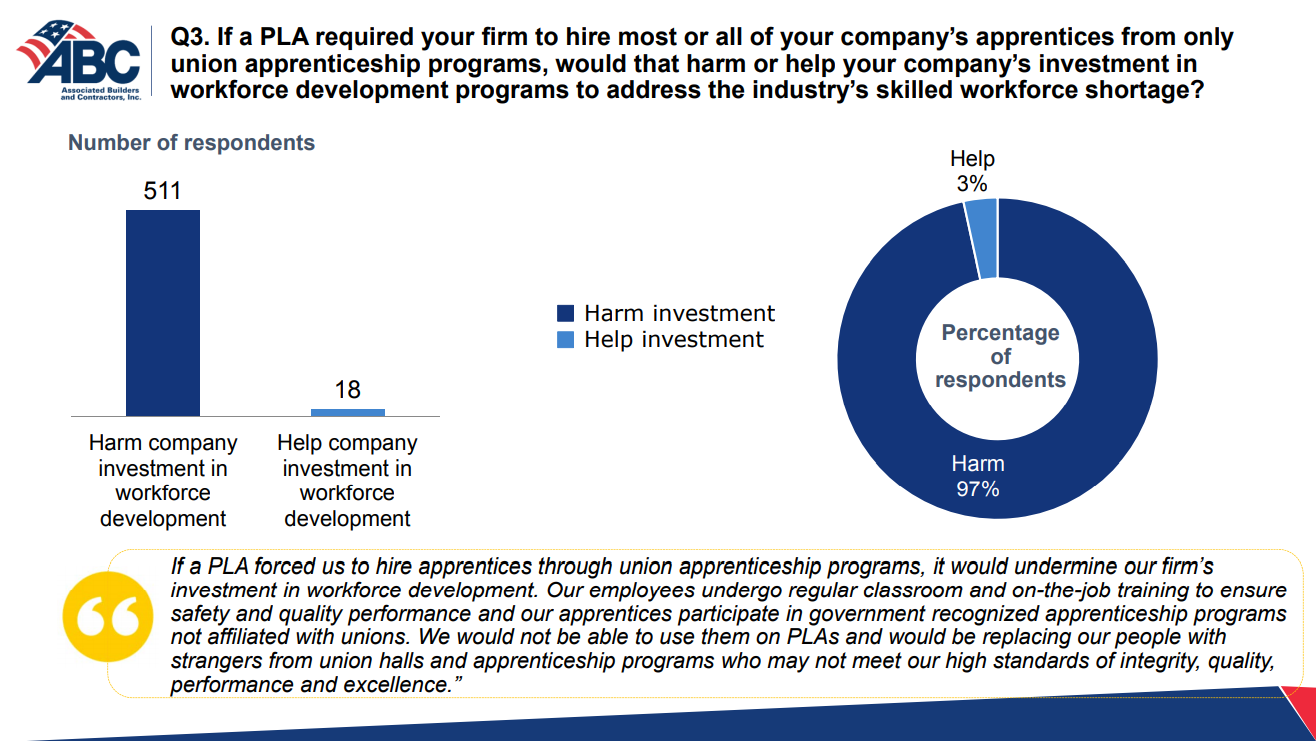
Even though more than 87% of the U.S. construction workforce chooses not to belong to a union, PLAs typically force contractors to hire most or all apprentices from union-affiliated apprenticeship programs, as specified in the PLA or applicable union’s Collective Bargaining Agreement referenced in the PLA.
For example, Article 13 of the PLA (pdf) mandated by lawmakers on the federally assisted District of Columbia’s South Capitol Street Corridor P – Phase 1 Project has the following problematic apprenticeship language on page 42, which forces contractors to use apprentices affiliated with union programs instead of their own existing apprentices, who are not affiliated with union programs:
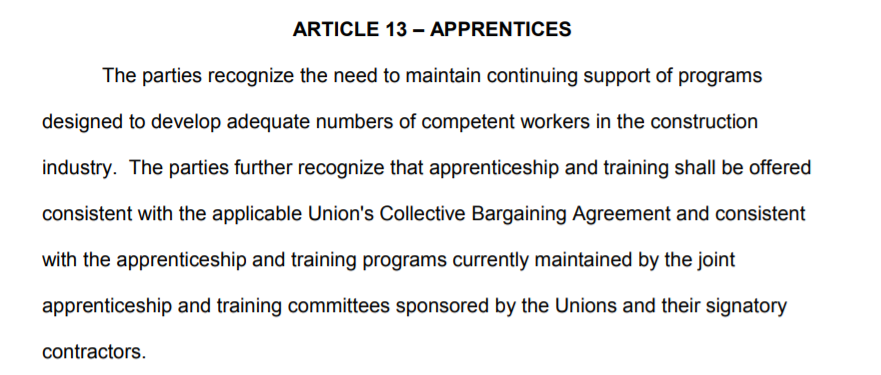
This project received federal assistance from the U.S. Department of Transportation’s Federal Highway Administration, which also approved the PLA mandated by the District of Columbia government.
ABC estimates the U.S. construction industry needs to hire an additional 550,000 workers in 2020 to meet the current backlog of construction projects—which stood at to 8.9 months in January 2020, according to ABC’s Construction Backlog Indicator—and future spending expectations. ABC’s latest Construction Confidence Index found that nearly 69% of contractors expect to increase staffing levels in the next six months.
According to the results of Associated Builders and Contractors’ 2019 Workforce Development Survey, ABC members invested $1.6 billion to educate their employees in 2018, providing craft, leadership and safety education to 980,000 course attendees to advance their careers in commercial and industrial construction. Safety education accounted for nearly half of the total workforce investment, averaging $1,306 per employee annually.
ABC has 1,400 training locations nationwide where we connect high school students, minorities, reentering citizens, veterans and women to rewarding careers in construction. ABC is building a workforce that is safe, skilled and productive, using innovative, competency-based, market-driven education methodologies and flexible learning models and apprenticeships in more than 50 professions.
The merit shop construction industry employs an all-of-the-above education approach that not only helps our workforce develop and achieve their career dreams, but also recognizes every worker is unique in their desires, skills and dreams. This all-of-the-above approach to workforce development has produced a network of ABC chapters and affiliates in 1,400 locations across the country that offer more than 800 apprenticeship, craft, safety and management education programs—including more than 300 U.S. Department of Labor and state equivalent government-registered apprenticeship programs across 20 different occupations—to build the people who build America.
When Associated Builders and Contractors signed the Pledge to America’s Workers at the White House in July 2018, it promised to educate and develop at least 500,000 construction workers by 2023. ABC has already far exceeded that goal in 2020.
However, the vast majority of tomorrow’s construction industry workforce—those participating in government-registered apprenticeship and industry-recognized apprenticeship programs not affiliated with unions—would not be able to meaningfully participate on government-mandated PLA jobs, stifling a key pipeline of skilled labor needed to meet America’s future infrastructure needs.
Construction Industry Workforce Development is Not Limited to Government-Registered Apprenticeship Programs and Union Apprenticeship Programs
Data from the U.S. DOL found that in 2019, a total of just 21,342 apprentices from the 25 Office of Apprenticeship states completed construction apprenticeship programs registered with the U.S. DOL. To be clear, the data is from OA federal registered programs affiliated with construction unions and programs not affiliated with unions such as those run by ABC chapters, ABC member contractors, community and technical education workforce development programs. That means that if the 2019 rate of graduation held constant, it would take 25 years for OA registered apprenticeship program completers to fill the estimated 550,000 vacant construction jobs needed in 2020 alone.
Of note, there are other government-registered apprenticeship programs regulated by states that are similar to the registered programs receiving oversight by the U.S. DOL OA. However, it is unknown how many apprentices completed construction industry apprenticeship programs registered with such state agencies, known as State Apprenticeship Agencies, in 2019.
The DOL Registered Apprenticeship Partners Information Data System, which receives data from all 25 OA states and 9 of the remaining SAA states plus Guam, estimated that in 2019, a total of 27,761 apprentices completed construction industry registered apprenticeship programs from RAPIDs participating states..
While it cannot be verified by government data due to data limitations in the RAPIDS program, it is estimated that about 35,000 to 40,000 apprentices completed government-registered apprenticeship programs from all 50 OA and SAA states and DC in 2019. At 2019 estimated graduation rates, it would take almost 14 years for all government-registered construction apprenticeship program completers to fill the estimated 550,000 vacant construction jobs needed just in 2020.
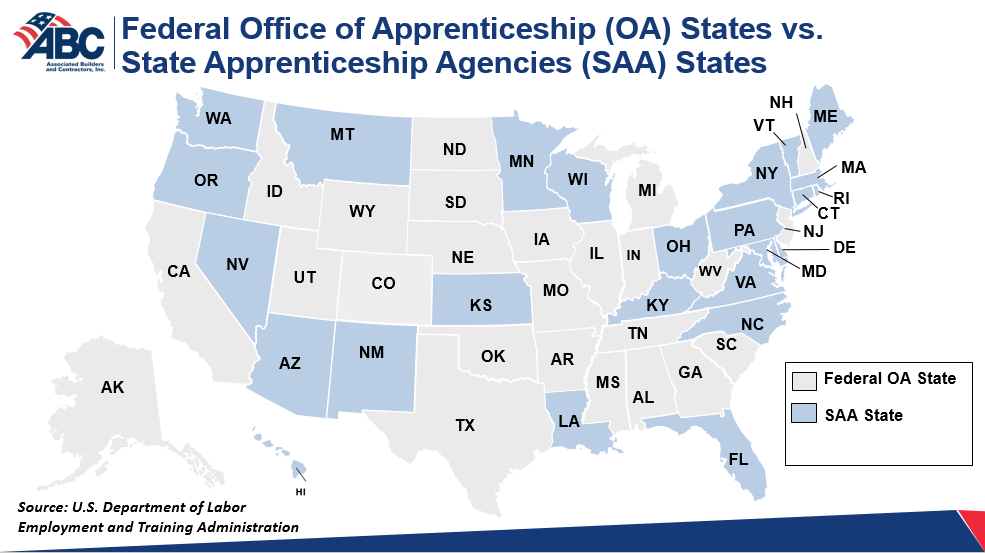
The Construction Industry Needs Lawmaker Support of an All-Of-The-Above Workforce Development Strategy
This data demonstrates that the vast majority of upskilling and workforce development in the construction industry occurs outside of union and nonunion government-registered apprenticeship programs. In addition, an even greater amount of construction industry workforce development and upskilling occurs in programs not affiliated with union government-registered apprenticeship programs because the union apprenticeship programs are almost all registered with the U.S. DOL or state equivalents.
This is why government-mandated PLAs that require employers to use apprentices from union-affiliated and/or government-registered apprenticeship programs is problematic from a practical perspective. Excluding the workforce development systems already in place exacerbates the skilled labor shortage facing the entire construction industry by steering work to participants in union-affiliated, government-registered apprenticeship programs at the expense of every other contractor bidding for work.
In short, there needs to be a commitment by policymakers to enact an all-of-the-above workforce development strategy where workers and employers have the freedom to choose the best way to rebuild America.
Survey Shows Widespread Opposition to Government-Mandated Project Labor Agreements
Of ABC survey respondents, 98% said they were less likely to bid on a taxpayer-funded construction contract if the bid specifications required the winning firm to sign a PLA with labor unions, and 97% of survey respondents said a construction contract that required a PLA would be more expensive compared to a contract procured via fair and open competition.
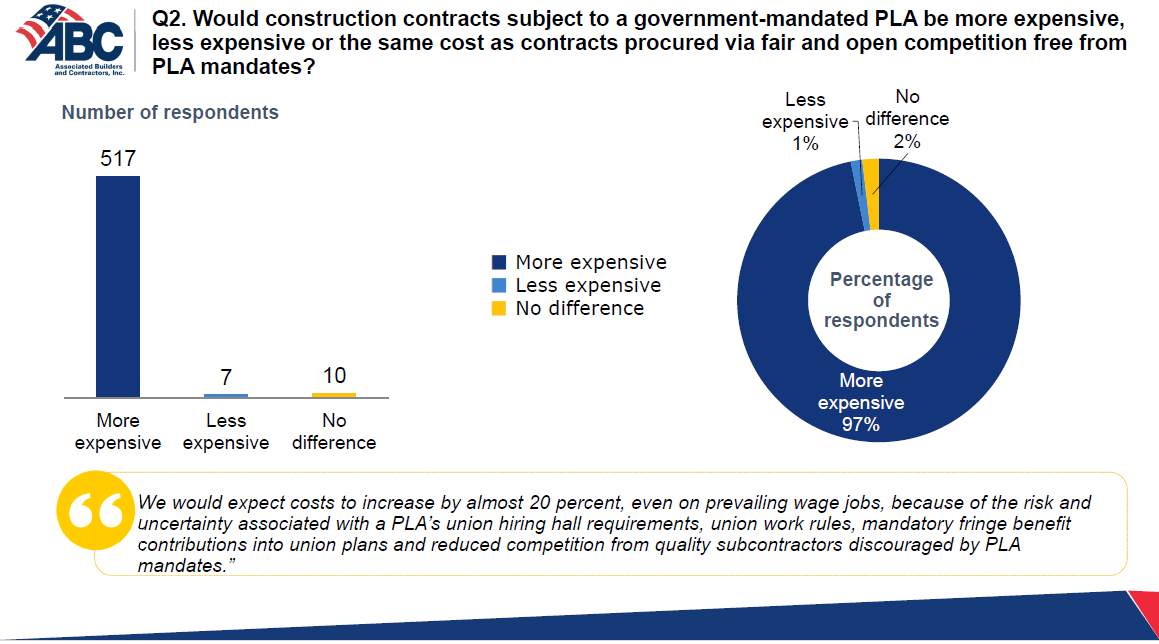
A clear majority of the more than 500 survey respondents affirmed that government-mandated PLAs are anti-competitive and discourage quality contractors. These PLAs also discourage the more than 87% of U.S. construction workers who choose to not join a union from bidding and working on projects in their own communities, which are paid for by their own tax dollars. In fact, 97% of survey respondents said a PLA would result in worse local hiring outcomes for a project. In addition, almost 90% of respondents agreed that a PLA would decrease the hiring of women, veteran and disadvantaged business enterprises and construction workers, which have traditionally been unaffiliated with labor unions.
Hardworking taxpayers deserve more efficient and effective policies that will encourage all qualified contractors to compete to build long-lasting, quality projects at the best price.
Federal and State Government-Mandated PLA Policies
In February 2009, President Obama signed Executive Order 13502, which encourages federal agencies to mandate PLAs on large-scale federal construction projects exceeding $25 million in total value on a case-by-case basis, and permits states and localities to mandate PLAs on federally assisted projects. ABC has continually fought government-mandated PLAs, advocated to rescind the federal government’s current pro-PLA mandate policy and supports measures ensuring fair and open competition on federal and federally assisted construction projects that help taxpayers get the best possible product at the best possible price.
“ABC supports fair and open competition measures and opposes government-mandated project labor agreements because hardworking taxpayers deserve more efficient and effective policies that will encourage all qualified contractors to compete to build long-lasting, quality projects at the best price,” said ABC Vice President of Regulatory, Labor and State Affairs Ben Brubeck. “It would be a real win-win for taxpayers and the U.S. economy if Congress and the Biden administration supported an inclusive policy so all Americans and all qualified companies can fairly compete to rebuild America’s infrastructure.”
Since former President Obama issued Executive Order 13502 in 2009, 26 states have responded to the threat of discriminatory PLA mandates and preferences by enacting Fair and Open Competition Act legislation prohibiting government-mandated PLAs on state and local taxpayer-funded construction projects to some degree to send a message to the federal government that PLA mandates are not welcome on local projects.
Unfortunately, some of these states have rolled back common-sense FOCA measures following Democratic party takeovers of state government, bringing the total number of current states with active pro-taxpayer FOCA measures to 25.
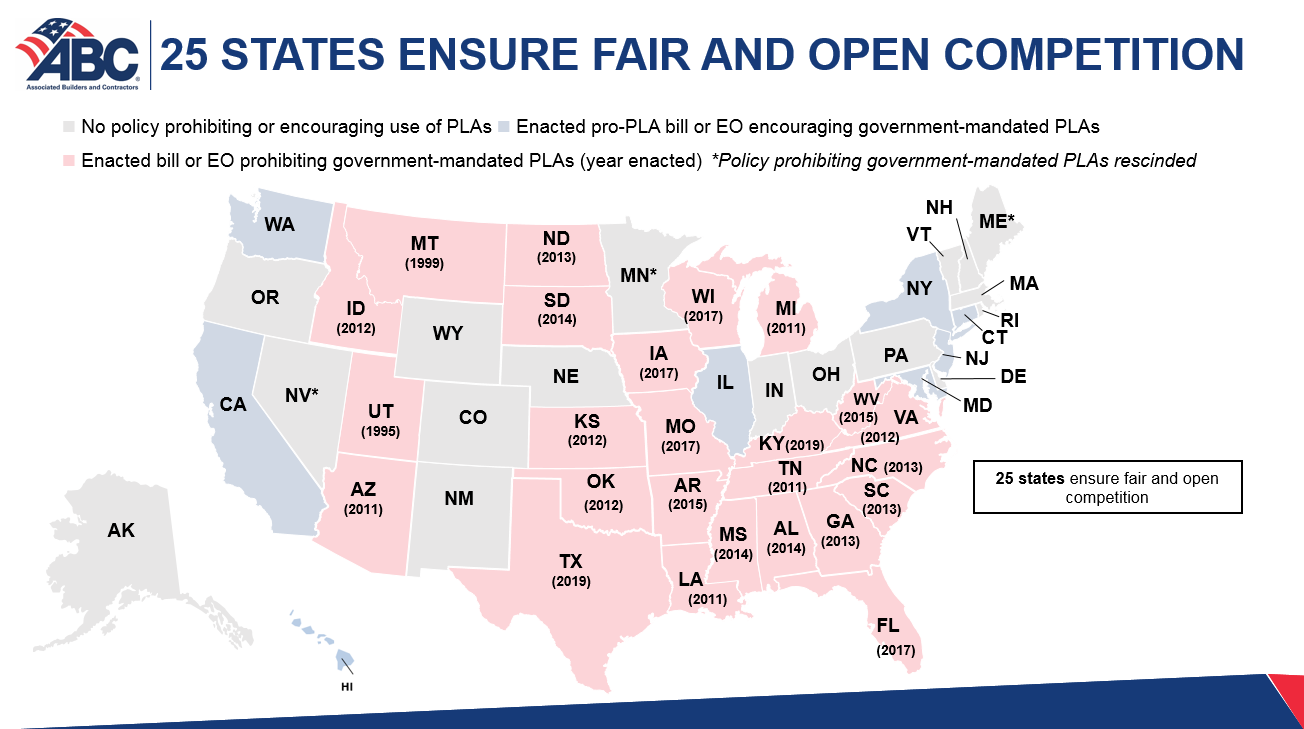
To date, all legal challenges to state and federal FOCA policies ensuring government neutrality in public works contracting have failed.
ABC’s efforts to enact state FOCA laws prevented government-mandated PLAs on $633 billion worth of construction capital outlay through the end of 2019.
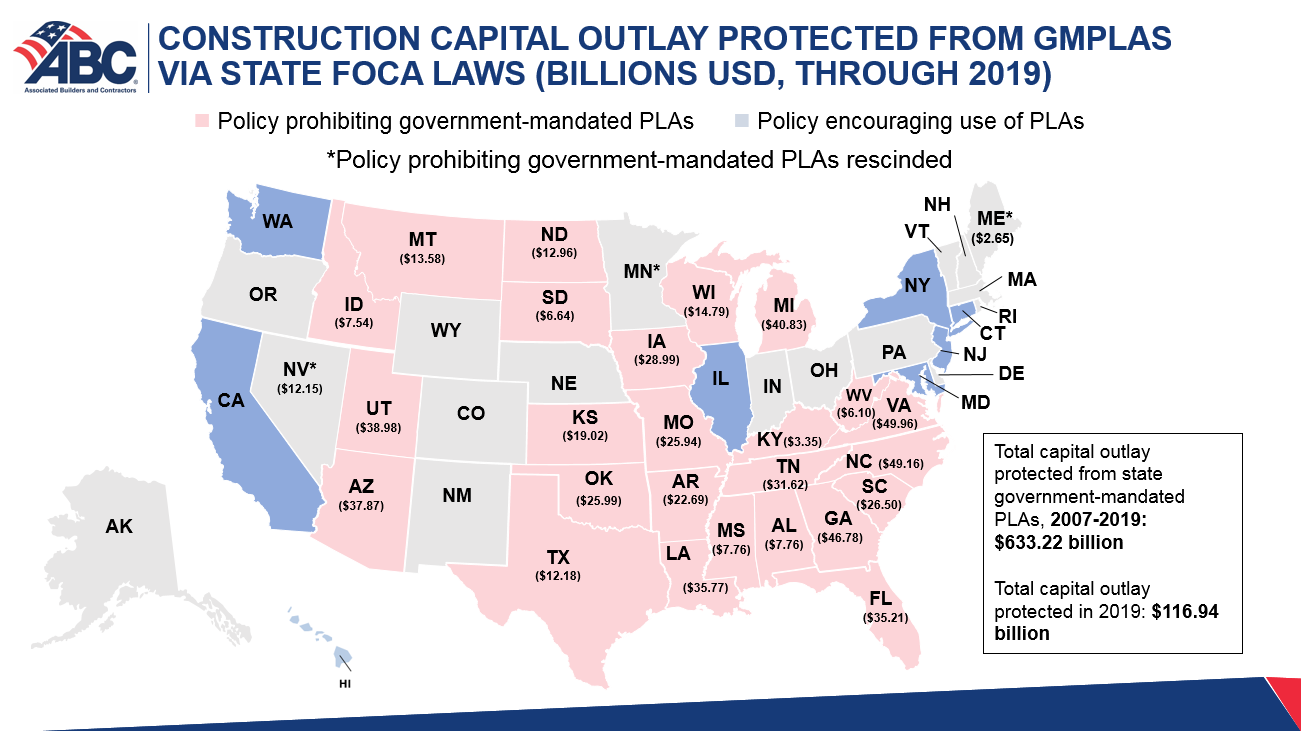
In addition, dozens of communities across the country have also enacted similar FOCA laws.
These efforts ensure a level playing field, increase competition, reduce costs and eliminate cronyism in public works contracting procured by state and local governments.
Corrupt Government-mandated PLAs Rig the Bidding Process
While ABC’s campaign against these anti-competitive schemes on federal projects has been largely successful, lawmakers requiring and encouraging the use of special interest-favoring PLA mandates on non-federal projects funded by federal, state and local tax dollars continues to needlessly cost hardworking taxpayers nearly 20% more per project and harm qualified merit shop contractors and their skilled trades employees.
According to a model developed by Markstein Advisors, every $1 billion in extra overall construction spending generates an average of at least 6,500 construction jobs, and every $1 billion in extra construction spending on infrastructure generates an average of at least 3,300 construction jobs. As the construction industry faces a 5.5% unemployment rate that is expected to grow due to a recession caused by the COVID-19 pandemic and America’s infrastructure remains critically underfunded, we need to be doing all we can to maximize taxpayer investments in infrastructure while helping all construction workers find quality jobs to rebuild their communities.
Problematic, anti-competitive terms in government-mandated PLAs require contractors to:
- Use union hiring halls to obtain most or all workers instead of their existing workforce.
- Obtain apprentices exclusively from union apprenticeship programs.
- Follow inefficient union work rules.
- Pay into union benefit and multi-employer pension plans that any limited number of nonunion employees permitted on the project will be unlikely to access unless they join a union and vest in these plans.
Research estimates that nonunion employees on PLA projects suffer an estimated 20% reduction in compensation and contractors pay an extra 25% in benefits costs to cover this PLA wage theft to union plans, making merit shop firms less competitive against unionized firms. In addition, any limited number of nonunion workers are forced to join a union and/or pay union dues as a condition of employment. The practical impact of government-mandated PLAs is that they discourage competition from qualified and local contractors and their skilled employees who want nothing more than to pursue their career dreams, provide for their families and rebuild their communities.
Contracts subject to government-mandated PLAs steer work to benefit union-signatory contractors and well-connected construction unions favored in PLAs, who use their members’ dues to support the political campaigns of candidates who pledge to push PLA mandates on taxpayer-funded projects that deny opportunities to the more 87% of U.S. private construction workers who choose not to join a union.
Potential PLA mandates on taxpayer-funded contracts expose officials to intense political pressure, as construction unions raise and spend millions of dollars to help elect lawmakers willing to pass policies that grant donors a monopoly on public works construction projects.
In 2020, ABC will continue to implement effective legislative, legal and regulatory strategies complemented by communications and grassroots campaigns to educate government procurement officials, lawmakers, industry stakeholders, the media and hardworking taxpayers about the harmful effects of special interest PLA schemes.
ABC will fight for federal, state, and local policies that create a level playing field in the procurement of government construction contracts, increase competition, help small businesses grow, curb construction costs and spread the job-creating benefits of taxpayer- funded contracts throughout the entire construction industry.











